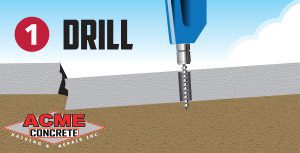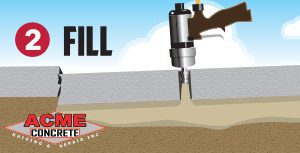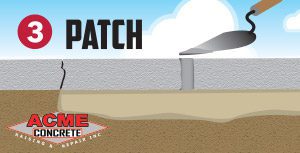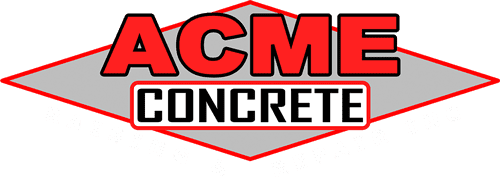At Acme Concrete Raising & Repair we only use high-density polyurethane foam to level and raise concrete throughout the Chicago area. We specialize in the concrete foam jacking method because it is proven to be faster, cleaner, cheaper and longer-lasting.
Although concrete raising results between polyurethane foam injections and old “mudjacking” methods may appear similar, there are significant differences between polyurethane and mudjacking methods. From the repair process to the materials and equipment used, our Smart Lift System® proves to be a far superior and sustainable repair method in the long term.
If you have an uneven sidewalk, driveway, or patio, contact the experts at Acme Concrete today for a foam injection quote. We’ll get your concrete slab repaired and level in no time at all!
How Does Polyurethane Foam Concrete Lifting Work?
As Chicagoland’s first contractor to focus specifically on raising sunken concrete with polyurethane foam, we developed the Smart Lift System® to provide our customers with the Ultimate Solution for Settled Concrete! The simple yet advanced foam injection technology allows Acme Concrete to raise sunken concrete with a three-step process:

Holes about the size of a dime are drilled into the settled concrete slab. Special injection ports are then installed allowing a clean, controlled injection of the polyurethane lifting foam.

A polyurethane injection gun is securely attached to the ports. Controlled injections are performed resulting in a two-part polymer flowing through the space between the structure and its failed subbase. The polymer forms a structural foam that fills voids while raising and leveling the settled structure.

Once the concrete has been raised, the lifting material is fully cured in about 15-minutes, allowing immediate, unrestricted use of the area. The injection ports are then easily removed and the holes are filled with a high quality grout leaving them virtually unnoticeable.
Check out the video below to see just how quick and simple it is to raise and level all types of concrete with our superior polyurethane foam concrete lifting equipment.
What to Expect When Lifting Concrete with Poly Foam
Our professional concrete lifting and leveling services are simple and effective. Research shows our state-of-the-art foam jacking process provides customers the highest-quality, and best-looking results possible. Also, we’re commitment to Health, Safety & the Environment! See below to learn more about our process of revitalizing sunken concrete and how Acme’s modern, quick and efficient poly foam injection method outperforms mudjacking.
| Acme Concrete Raising & Repair Polyurethane Injection | Typical Mudjacking |
Modern Poly Foam EquipmentPolyurethane Foam Injection Polyurethane foam concrete lifting projects typically require a small box truck or pickup truck & small trailer. The required poly foam equipment and materials are located in this single vehicle – no heavy construction trucks or equipment are needed. Our concrete lifting foams are centrally located and ready to use on demand. There is no manual mixing required, saving labor and time. |
Mudjacking Most mudjackers use heavy duty construction vehicles. Dump trucks may also be used in mudjacking. |
Small Holes for Less Invasive Concrete LiftingPolyurethane Foam Injection To begin, we create a few small holes (about the size of a dime) in the concrete allowing us to inject the polyurethane foam lifting material. Once the holes are placed in strategic locations, special injection ports are installed creating a secure, sealed connection between our lifting equipment and the concrete. This unique feature prevents the poly foam from leaking or spilling during the concrete raising process. The overall benefit of injection ports is a cleaner work area and much smaller patches. Learn more about injection hole patches. |
Mudjacking Mudjacking will typically require much larger holes – ranging anywhere from 1” to 2” in diameter. Most mudjackers do not use injection ports. Material spills and leaks can occur causing a messy work area and require cleaning. |
Injection Hole QuantityPolyurethane Foam Injection Polyurethane is injected as a thin liquid and travels easily between the slab and subsurface, therefore requiring fewer holes to obtain the required coverage. |
Mudjacking Most mudjacking operations utilize a very viscous or thick mixture that is unable to travel as easily as liquid polyurethane. |
Polyurethane Slab Lifting ProcessPolyurethane Foam Injection We then connect advanced, computer-controlled equipment to the injection ports and inject a two-part polymer. The materials travel laterally beneath the concrete, reacting and expanding to permanently fill voids while simultaneously raising and leveling the sunken concrete. The polyurethane slab lifting process is quite simple. |
Mudjacking Depending on the contractor, mudjackers pump various wet mixtures below the concrete. (every mudjacker uses their own "recipe") Slabs are sometimes “over-raised” to account for future shrinkage. |
Clean & Fast Equipment RemovalPolyurethane Foam Injection Following the lifting process, injection ports are removed, leaving a clean repair and neatly maintained work area. Since the bulk of our poly foam injection equipment is remote and self-contained, equipment removal is as simple as rolling up a hose. And due to the nature of our clean repair technology, cleaning of equipment or the work itself is extremely minimal. |
Mudjacking Since the mudjacking repair process can be a bit sloppy at times, mudjackers typically need to wash down the repaired surfaces before material dries. They may also need to wash mud mixers and pumps before material dries and clogs up their equipment. |
Ready to Use Quickly After InjectionPolyurethane Foam Injection The poly foam jacking material we use to lift and level concrete is fully cured in about 15-minutes after injection. It doesn’t matter what type of structure we raise; a sidewalk, garage floor, driveway, parking lot, etc. When the job is complete, the concrete is free to use without restriction. |
Mudjacking Some mudjacking slurries can require 24 to 48 hours to fully cure. Normal use of the concrete may need to be avoided for days following a repair. |
Here Are the FAQ's Regarding Mudjacking
In today’s day and age, it’s pretty widely understood that “Mudjacking” is now an inferior repair when compared to current technology. However, we do still get asked questions about it from people conducting their own research. Here are some common questions and answers that relate to old Mudjacking technology.
Q: What is Mudjacking?
A: Mudjacking, also known as “mud jacking”, is a concrete leveling method that involves pumping a mixture of sand, soil, and water underneath a sunken or settled concrete slab in order to lift and level it. Mudjacking has some inherent drawbacks in terms of control, appearance, and long-term durability compared to newer methods like polyurethane foam leveling.
Q: How does Mudjacking work?
A: Holes are drilled into the sunken or settled concrete slab, typically around 1.5-2.5 inches in diameter. Then an aggregate based slurry, usually consisting of water, sand, and a very small amount of cement, is then pumped through these holes and under the concrete slab. The high-pressure pumping of the slurry exerts upward pressure, lifting the slab back to its original level position. Once the slab is lifted, the drill holes are then filled and patched, which does not typically match the existing slab. After 24 hours, the repaired concrete slab would finally be ready for use again.
Q: Can mudjacking holes cause cracking if not done carefully?
When drilling holes in concrete for mudjacking, careful attention must be used. The process typically involves drilling 1.5-2 inch holes through the concrete slab to inject a mudjacking slurry mixture of sand, cement, and soil. It is crucial to perform this task in a way that avoids creating stress points that can lead to cracking. If holes are improperly placed or spaced, it can result in anything from minor cracks to significant breaks in the concrete slab. These cracks not only weaken the structural integrity of the concrete but also make it difficult to achieve a smooth, level surface after mudjacking.
Also, the mudjacking slurry itself is susceptible to shrinking, erosion, and breakdown when exposed to water, freeze-thaw cycles, and other environmental factors. This can cause the lifted concrete to sink again as the underlying support material deteriorates. The drilled holes, if not properly patched or sealed, can allow water, weeds, and other environmental elements to penetrate the concrete.
It’s important for the drilling process to be conducted with precision and care, using the correct tools and techniques to minimize the risk of creating immediate and long-term damage to the concrete structure.
Q: How long does Mudjacking last?
A: Mudjacking can provide a temporary fix for sunken concrete, however, it is generally considered a less durable and less long-lasting solution compared to newer methods like polyurethane foam lifting. Most experts suggest mudjacking may only last about a year before the concrete needs to be re-lifted.
Q: Why does concrete that was Mudjacked re-settle so soon?
The mudjacking slurry mixture of sand, cement, and soil is susceptible to shrinking, erosion, and breakdown when exposed to water, freeze-thaw cycles, and other environmental factors. This can cause the lifted concrete to sink again as the underlying support material deteriorates.
The mudjacking slurry weighs around 100 pounds per cubic foot, which is much heavier than the 2.5-4 pounds per cubic foot of polyurethane foam used in alternative methods. This heavy weight can cause the soil underneath to compress and settle over time, leading the concrete slab to sink again.
Drilling 1-2 inch holes through the concrete slab to inject the slurry can create weak points and cracks that worsen over time. These holes are also difficult to properly seal and can allow water, weeds, and other issues to penetrate the concrete.
Can you DIY mudjacking?
According to experts, it is generally advised against attempting DIY mudjacking. The process of mudjacking typically involves using cement, sand, soil, and a specialized jacking pump. Without access to these materials and equipment, it is generally recommended to seek the assistance of a professional. This is because improper mudjacking techniques can potentially result in the cracking or irreversible damage of the concrete slab. To ensure the best outcome and avoid potential costly repairs, it is advisable to entrust the task of mudjacking to experienced professionals. Although it is important to note, ACME does not typically recommend Mudjacking due to how invasive and temporary the repairs are.
What are some alternatives to DIY mudjacking for concrete leveling?
Several alternatives exist for leveling concrete aside from DIY mudjacking, each with its pros and cons:
1. Hiring a Professional Concrete Leveling Service: Opting for professional services offers a significant advantages due to the expertise and specialized equipment possessed by the professionals. We’re NOT talking about multi-service or multi-purpose companies like concrete coating or waterproofers, we’re referring to true concrete-raising specialists that ONLY raise concrete. This level of expertise translates into more effective and longer-lasting results compared to DIY methods or services provided by multi-service companies.
2. Concrete Grinding: This technique involves grinding down the higher parts of the concrete to align with the lower parts, thereby eliminating tripping hazards. Although this method can be faster and less costly, it is definitely an eye-sore and leaves the concrete looking uneven or patched. Grinding can also prevent future raising to correct grade and pitch issues.
3. Applying a Concrete Overlay: Adding a new layer of concrete over the existing uneven areas is another approach, although not recommended in most cases. This method could provide a temporary fix and make areas safer by reducing unevenness. However, this new layer likely will not match or adhere well to the existing concrete, potentially leading to quicker deterioration and chipping.
Can mudjacking be done in the winter?
Mudjacking can be performed in the winter, provided certain conditions are met as temperature can play a crucial role in the success of mudjacking. If the climate is too cold, the setting process of the mudjacking slurry may take longer than usual. Additionally, if the concrete is frozen to the ground, it may crack as the slab is trying to be raised.

